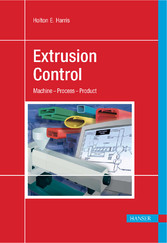Holton E. Harris
Extrusion Control
Machine - Process - Product
Contents
Contents
I Introduction
14
1 Introduction
16
2 The Extrusion Line
18
2.1 The Extruder
18
2.2 Pumping
19
2.2.1 The Path the Plastic Takes
20
2.2.2 The Gear Box – RPM
21
2.3 Safety
22
II Control of the Machine
24
3 The Concepts of Total Control
26
3.1 Overview
26
3.1.1 Sheet Extrusion
28
3.1.2 Blown Film Extrusion
29
3.1.3 Wire Extrusion Coating
29
3.1.4 Foam Extrusion
29
3.1.5 Coextrusion
30
3.1.6 Alternate Polymer Extrusion
30
3.1.7 "Lights-Out" Extrusion Systems
30
3.2 Total Control
31
3.3 Aspects of Control
32
3.3.1 Machine Control
32
3.3.2 Process Control
32
3.3.3 Product Control
32
3.3.4 Plant-Wide Control
33
3.3.5 Statistical Quality Control
33
4 Control of Temperature
34
4.1 The Real World
36
4.2 Temperature Controllers
37
4.2.1 On/Off Controls
38
4.2.2 Simple Proportional Controller
39
4.2.3 Proportional Plus Automatic Reset Controllers
41
4.2.4 Fuzzy Logic
44
4.3 Sensing of Temperature
44
4.3.1 Placement of Temperature Sensors
44
4.3.2 Dual Sensing
45
4.3.3 Types of Sensors
46
4.4 Control of Heating and Cooling Power
54
4.4.1 Mechanical Contactors
54
4.4.2 Mercury Contactors
54
4.4.3 Solid State Contactors
55
4.4.4 Phase Control–True Proportional Control of Power
55
4.4.5 RFI-Free Solid State Power Modules
4.4.5 RFI-Free Solid State Power Modules
5 Control of RPM
58
5.1 Brush Type D-C Motors and Drives
59
5.1.1 How Does a Motor Work?
60
5.1.2 Drives for D-C Brush Type Motors
62
5.1.3 Net Excitation Voltage
63
5.1.4 Field Excitation
64
5.1.5 Accuracy
65
5.1.6 Synchronization of Multiple Motors
66
5.2 Vector Drives
67
5.2.1 The Motor
68
5.2.2 Flux Vector Drives
69
III Control of the Process
70
6. Control of the Plastic
72
6.1 Measurement and Control of the Quantity of Plastic Passing Through the Die
73
6.1.1 Don't Be a Luddite!
73
6.2 When and Why Should a Melt Pump Be Used?
74
6.3 Stabilizing the Throughput
78
6.4 Microprocessor Melt Pump Control
79
6.5 Other Advantages of Using a Melt Pump
82
6.6 Measurement and Control of Melt Pressure
83
6.7 Measurement and Control of Melt Temperature
84
6.8 Measurement and Control of Viscosity–The Final Frontier!
86
6.8.1 Precise Measurement of Viscosity
87
6.9 Summary
88
IV Control of the Final Product
90
7 Sheet Extrusion
92
7.1 Materials, Machines, and Applications
92
7.1.1 The Die
94
7.1.2 The Roll Stack
95
7.1.3 Measurement of Thickness
96
7.2 Automated Profile Control
99
7.3 Coextrusion
100
7.3.1 Feed Block Dies
101
7.3.2 Multi-Manifold Dies
102
8 Tubing
104
8.1 The Extruder
105
8.2 Free-Air Extrusion
106
8.2.1 The In-Line Die
106
8.2.2 Crosshead Dies
107
8.3 Cooling the Tubing - the Water Bath
108
8.4 Vacuum Sizing
109
8.4.1 The Die
109
8.4.2 The Vacuum Sizing Chamber
109
8.4.3 The Vacuum Pump
110
8.5 The Cutter
111
8.6 Measuring Product Parameters
112
8.6.1 The Outside Diameter
112
8.6.2 Measurement of the Inner Diameter by Calculation
112
8.6.3 Measurement of the Inner Diameter by Ultrasonic Gauging
113
8.6.4 Measurement of Concentricity
113
8.6.5 How Can Outer and Inner Diameter Be Varied?
114
8.6.6 Automated Control of the Outer Diameter
115
8.6.7 Automated Control of the Inner Diameter
115
8.6.8 Combined Automated Control
115
8.7 Multi-Lumen Tubing
116
8.8 "Bump" Tubing.
116
8.9 Alternate Polymer System
117
8.10 Control of Length – The Puller
118
8.10.1 Caterpillar Belt versus Rollers
118
8.11 Control of Puller Motor RPM
119
8.12 Coextrusion
120
8.12.1 Special Considerations for Medical Tubing Applications
121
8.13 Integrated System Control
123
9 Other Types
9 Other Types
126
126
9.1 Blown Film Extrusion
126
9.1.1 Control of Thickness in the Cross-Machine Direction
126
9.1.2 Control of Average Sheet Thickness in the Machine Direction
127
9.1.3 Measurement of Bubble Thickness
127
9.1.4 Advantages of Using a Melt Pump
128
9.2 Wire Coating Extrusion
128
9.2.1 Wire Coating with Foam Insulation
129
9.2.2 Coextruded Wire Coating
130
9.3 Fiber Optics Extrusion
130
9.4 Profile Extrusion
131
10 Unattended Operation
134
V Plant-Wide Control
136
11 Plant-Wide Control and Management
138
11.1 The Renort Procram
139
11.1.1 The Time Machine
139
11.2 Run Sheets and Recipe Storage
140
11.3 The Alarm Loc Viewer
141
11.4 Statistical Quality Control
141
VI Overall SQC
144
12 Statistical
12 Statistical
146
146
12.1 Acceptable Quality Level – AQL
146
12.2 Strip Chart Recorders
148
12.3 What Was Deming Teaching?
148
12.4 Deming Goes to Japan
149
12.5 Quality Measurement - X and
12.5 Quality Measurement - X and
12.6 Numerical Analysis
152
12.7 How Many Measurements?
153
12.8 How Much Faith Can We Put in the Measurements?
154
12.9 Make Sure You Are Measuring What You Think You Are!
155
12.10 Significance
156
12.11 Control Charts
156
12.12 s
12.12 s
158
158
12.13 Statistical Quality Control Since Deming
159
12.14 The Larger Picture
161
Index
162
About the Author
168
© 2009-2024 ciando GmbH
 Zu Hanser-Fachbuch.de
Zu Hanser-Fachbuch.de
 Warenkorb
Warenkorb
